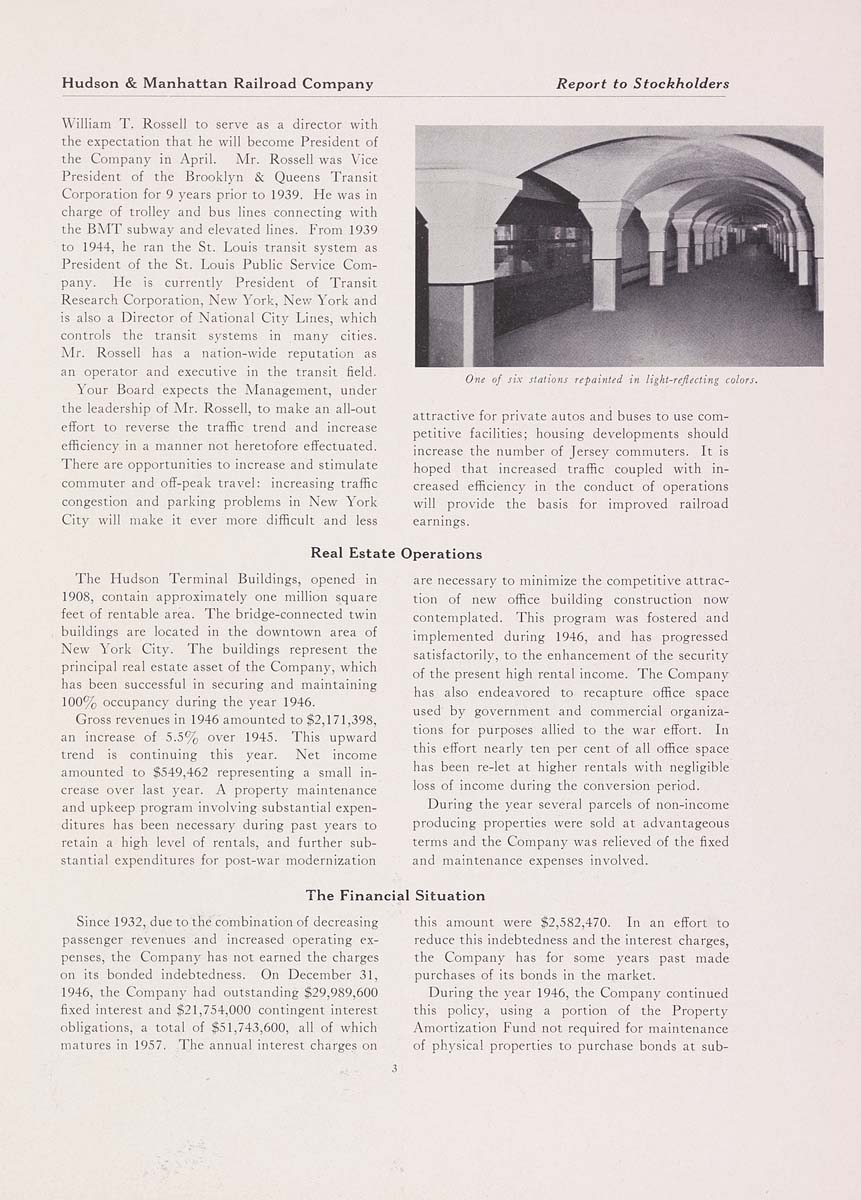Annual report of Hudson & Manhattan Railroad Company
(New York, N.Y. : Hudson and Manhattan Railroad Company )
|
||
|
|
|
|
| 1946: Page 3 |

Hudson & Manhattan Railroad Company Report to Stockholders William T. Rossell to serve as a director with the expectation that he will become President of the Company in April. Mr. Rossell was Vice President of the Brooklyn & Queens Transit Corporation for 9 3'ears prior to 1939. He was in charge of trolley and bus lines connecting with the BMT subway and elevated lines. From 1939 to 1944, he ran the St. Louis transit system as President of the St. Louis Public Service Com¬ pany. He is currently President of Transit Research Corporation, New York, New York and Is also a Director of National City Lines, which controls the transit systems in many cities, Mr. Rossell has a nation-wide reputation as an operator and executive in the transit field. Your Board expects the Management, under the leadership of Mr. Rossell, to make an all-out effort to reverse the traffic trend and increase efficiency in a manner not heretofore effectuated. There are opportunities to increase and stimulate commuter and off-peak travel: increasing traffic congestion and parking problems in New York City will make it ever more difficult and less attractive for private autos and buses to use com¬ petitive facilities; housing developments should increase the number of Jersey commuters. It is hoped that increased traffic coupled with in¬ creased efficiency in the conduct of operations will provide the basis for improved railroad earnings. Real Estate Operations The Hudson Terminal Buildings, opened in 1908, contain approximately one million square feet of rentable area. The bridge-connected twin buildings are located in the downtown area of New York City. The buildings represent the principal real estate asset of the Company, which has been successful in securing and maintaining 100% occupancy during the year 1946. Gross revenues in 1946 amounted to $2,171,398, an increase of 5.5% over 1945. This upward trend is continuing this year. Net income amounted to $549,462 representing a small in¬ crease over last year. A property maintenance and upkeep program involving substantial expen¬ ditures has been necessary during past years to retain a high level of rentals, and further sub¬ stantial expenditures for post-war modernization are necessary to minimize the competitive attrac¬ tion of new office building construction now contemplated. This program was fostered and implemented during 1946, and has progressed satisfactorily, to the enhancement of the security of the present high rental income. The Company has also endeavored to recapture office space used by government and commercial organiza¬ tions for purposes allied to the war effort. In this effort nearly ten per cent of all office space has been re-let at higher rentals with negligible loss of income during the conversion period. During the year several parcels of non-income producing properties were sold at advantageous terms and the Company was relieved of the fixed and maintenance expenses involved. The Financial Situation Since 1932, due to the combination of decreasing passenger revenues and increased operating ex¬ penses, the Company has not earned the charges on its bonded indebtedness. On December 31, 1946, the Company had outstanding $29,989,600 fixed interest and $21,754,000 contingent interest obligations, a total of $51,743,600, all of which matures In 1957. The annual interest charges on this amount were $2,582,470. In an effort to reduce this indebtedness and the interest charges, the Company has for some years past made purchases of its bonds in the market. During the year 1946, the Company continued this policy, using a portion of the Property Amortization Fund not required for maintenance of physical properties to purchase bonds at sub- |
| 1946: Page 3 |







